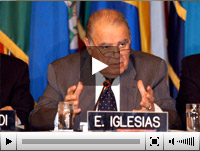- English
Cátedra de las Américas
Second Lecture - Enrique Iglesias
Second Lecture - February 8, 2005
"The Americas: From Economic Integration to Full Cooperation"
Orador:
Enrique Iglesias, former President of the Inter-American Development Bank
Chairman of the Permanent Council, Acting Secretary General, Chairman of the Committee on Juridical and Political Affairs, Dean, Representatives, friends here in this room and those who are listening to the broadcast. I would like to begin by once again thanking the OAS for this invitation that is a very great honor and also to be commended for this initiative.
Embajador Alberto Borea described to me some time ago what it was about and I thought it was a excellent idea to have an opportunity for a dialog and to avail ourselves of the new mechanisms for broadcasting in order to share it with the Americas. I think this is an excellent idea, it’s good for us, it’s good for the OAS, good for all of us, and for this reason we accepted to participate and share some ideas in regards to the subject that I wanted to address to you.
It’s a great pleasure for the President of the IDB to be at the OAS, we are part of this family, we were born under their auspices and to a certain extent we were conceived in this very same organization many years ago.
I usually recall something that we underscored with the brief history of how the bank was born 40 years ago. This is something that not everybody knows and those who recall the conference of 1888 or 89 thereabouts as the conference that gave rise to the long path that ultimately ended in establishing this organization. But sometimes what we forget is that in that conference convened by the government of the United States or rather the Congress of the United States that asked the President to convene that meeting, there were three initiatives.
One was the creation of a common market; the second was the establishment of a common currency and the third, the establishment of a bank. So with the birth of the OAS, there was this idea also of establishing the bank; you took 20 years, it took us 70 years. It was a longer delivery time but we did finally end up being created after many of the meetings that were carried out within the OAS over that 70-year span.
The projects were negotiated and discussed until finally the institution was established thanks to the meeting between President Eisenhower and President Kubtischek. So we feel at home here and it is a pleasure to share with you some outcomes of our personal experience and institutional experience. When I was given the title for the conference “the Americas from Economic Integration to Full Cooperation”, the first question I asked myself was: What integration are we talking about? Are we talking about regional integration or Latin America and the Caribbean or are we talking about the hemispheric integration? And I really think that that is the core subject since we are at the OAS. But nonetheless, it is worth while clarifying that because the term and cooperation goes along many paths in our region.
We have the regional channel in the strict sense of Latin America and the Caribbean. We have the hemispheric channel and this gave rise to hemispherism, if you allow us to coin a word and ultimately we have global or international cooperation through the global entities. In the three areas, Latin America is truly an example of important action, sometimes not highly valued, but the region has played and has important actions in the area of regional integration of Latin America and the Caribbean. For many years, it has already been active in hemispheric cooperation and it has a growing participation at international fora.
Regionalism in Latin America was born at the time of Bolivar and it was maybe the first call for cooperation among countries to build together a common future. And quite honestly, we should say that if we look at our regions and these 200 or 180 years of experience, despite some painful conflicts, this region, nonetheless, in its struggle for peace does not leave its place to anybody else, it is important to state this. We have had more years at peace than at war or in conflict but there have also been many years at construction, of building and this organization has been at the center of a lot of these activities.
In the fifties, there is a certain level of economic regionalism at CEPAL at the time and Raul Previch began to incorporate the economic model of substituting imports and that is in its notion of regionalism and it does it with a broad vision because in 1952, these seeds were sown for Central American economic integration and that was even before the European integration. There was an initiative but it wasn't yet formally established in Europe.

